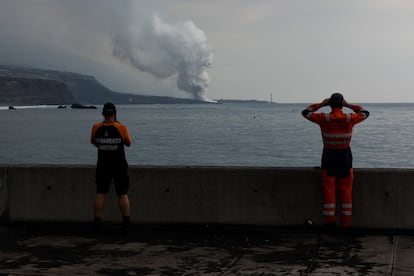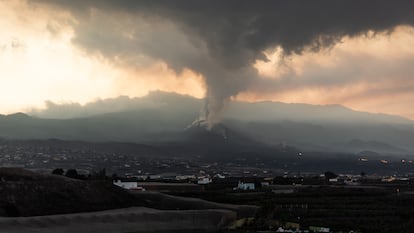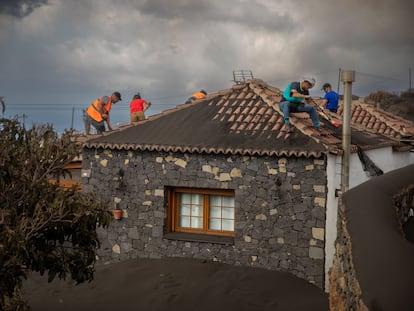Flights canceled and classes suspended as La Palma eruption affects air quality
The volcano, which has been erupting since late September, is losing energy but continues to spew ash and lava on the Spanish island

Air quality is deteriorating on the Spanish island of La Palma, according to experts monitoring a volcanic eruption that began there on September 19.
There were school closures and flight cancellations on Tuesday due to worsening air conditions, particularly in the Valley of Aridane, on the western side of the island. La Palma is part of the Canary Islands, a Spanish archipelago located off the northwestern coast of Africa.
Nearly two months after it began erupting in the Cumbre Vieja mountains, the volcano has destroyed over 1,000 hectares of land, forced many residents to evacuate their homes and damaged the local economy.
“We’ve had significant gas levels in the south end of the evacuated zone; this has slowed down the arrival of personnel in the area of El Charco, making it impossible [for professional cleaning staff] to go in to clear the rooftops and water the crops,” said Miguel Ángel Morcuende, technical director of the Canary Islands Volcano Prevention Plan (Pevolca), which is managing the crisis. A 72-year-old man died last week while clearing away ash from his home in the town of Los Llanos de Aridane.
On Tuesday, five municipalities within the Valley of Aridane told students to stay home and La Palma airport halted four flights due to the poor air quality.
While scientists believe that the volcano is losing energy, the eruption “will not be ending in the short term,” warned María José Blanco, the spokesperson for Pevolca’s scientific committee. This warning was issued despite the fact that most observable parameters related to the eruption are dropping, particularly volcanic tremor, ground uplift and sulfur dioxide emissions.

Between 3,000 and 3,500 tons of these emissions were recorded in the last few hours, a significant drop from 12,000 to 15,000 tons the previous day. But this downward trend remains slow, according to the experts. Volcanic tremor, on the other hand, has picked up slightly in the past 24 hours. This indicator represents the sound made by the magma flow on its way up to the surface, and any increase could mean that either there is a greater amount of magma or that it is rising faster. “We’re going to keep an eye on this over the next few days,” said Morcuende.
Monitoring stations also recorded an earthquake at 1am at a depth of 38 kilometers, measuring 3.8 on the Richter scale. The tremor was not felt above ground. Meanwhile, lava has covered 1,042 hectares of land and destroyed 2,623 buildings, according to data provided by the European satellite program Copernicus. More precise statistics provided by island property records that factor out structures like swimming pools and tool sheds place the number of damaged buildings at 1,472. Of these, 1,181 are for residential use.
Meanwhile, streams of molten rock continued to fill in the gaps between the main lava channels and extended into new parts of the southern end of the affected area. The delta created by the lava flowing into the sea has grown by one hectare to reach close to 42 hectares, according to figures from the Geological and Mining Institute of Spain.
Mariano Zapata, president of the island authority of La Palma, said on Tuesday that “60 days is too long to be gone from your house,” particularly for those who have lost their homes to the volcano and are demanding solutions. Zapata said that all levels of administration are working “at top speed” to get this matter solved.
Local authorities in Los Llanos de Aridane on Tuesday confirmed that they have ceded two plots of land to the regional government of the Canary Islands for a project to build new housing for people who have lost their homes. One plot is situated in an area known as El Jable and could hold up to 78 temporary homes, and the other one is located in La Montaña and could hold a residential building with 22 apartments.
Tu suscripción se está usando en otro dispositivo
¿Quieres añadir otro usuario a tu suscripción?
Si continúas leyendo en este dispositivo, no se podrá leer en el otro.
FlechaTu suscripción se está usando en otro dispositivo y solo puedes acceder a EL PAÍS desde un dispositivo a la vez.
Si quieres compartir tu cuenta, cambia tu suscripción a la modalidad Premium, así podrás añadir otro usuario. Cada uno accederá con su propia cuenta de email, lo que os permitirá personalizar vuestra experiencia en EL PAÍS.
¿Tienes una suscripción de empresa? Accede aquí para contratar más cuentas.
En el caso de no saber quién está usando tu cuenta, te recomendamos cambiar tu contraseña aquí.
Si decides continuar compartiendo tu cuenta, este mensaje se mostrará en tu dispositivo y en el de la otra persona que está usando tu cuenta de forma indefinida, afectando a tu experiencia de lectura. Puedes consultar aquí los términos y condiciones de la suscripción digital.
More information
Últimas noticias
Russian ultranationalism, inflamed by the killing of the hooligan commander ‘Spaniard’
The relentless struggle between factions deepens the Sinaloa war: bodies in coolers and a surge in homicides
‘Doctor Death’, the journalist who has witnessed 105 executions in Florida
Being trans or gay in a migrant detention center: ‘They call me faggot, queer, bitch’
Most viewed
- The low-cost creative revolution: How technology is making art accessible to everyone
- Christian Louboutin: ‘Young people don’t want to be like their parents. And if their parents wear sneakers, they’re going to look for something else’
- All the effects of gentrification in one corner of Mexico’s Colonia Roma
- Liset Menéndez de la Prida, neuroscientist: ‘It’s not normal to constantly seek pleasure; it’s important to be bored, to be calm’
- Christmas loses its festive spirit: ICE fears cast shadow over religious celebrations











































